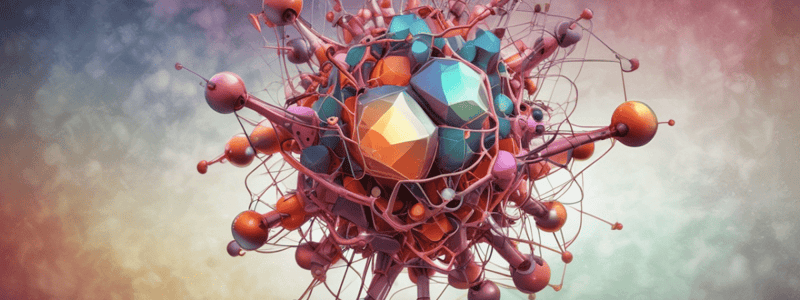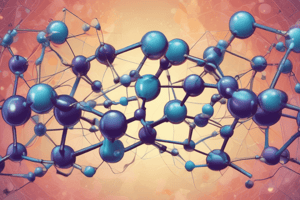Podcast
Questions and Answers
What is the reason for preparing amides and esters from acid chlorides instead of the acid itself?
What is the reason for preparing amides and esters from acid chlorides instead of the acid itself?
- Acids are difficult to handle
- Acid chlorides are more readily available
- Acid chlorides are cheaper than acids
- Reactions with acid chlorides are faster and more irreversible (correct)
What is the difference in reactivity between aliphatic and aromatic acid chlorides?
What is the difference in reactivity between aliphatic and aromatic acid chlorides?
- Aliphatic acid chlorides are more reactive than aromatic acid chlorides
- Aromatic acid chlorides are less reactive than aliphatic acid chlorides (correct)
- There is no difference in reactivity between aliphatic and aromatic acid chlorides
- Aromatic acid chlorides are more reactive than aliphatic acid chlorides
What is the purpose of adding a base in the Schotten-Baumann technique?
What is the purpose of adding a base in the Schotten-Baumann technique?
- To react with the acid chloride
- To increase the temperature of the reaction
- To reduce the concentration of the hydroxy compound
- To catalyze the reaction and neutralize the hydrogen chloride (correct)
What is the outcome of the reaction between acetyl chloride and cold water?
What is the outcome of the reaction between acetyl chloride and cold water?
What is the difference between the reactions of acetyl chloride and benzoyl chloride with cold water?
What is the difference between the reactions of acetyl chloride and benzoyl chloride with cold water?
What is the role of pyridine in the reaction?
What is the role of pyridine in the reaction?
What is the advantage of carrying out two rapid reactions instead of one slow reaction?
What is the advantage of carrying out two rapid reactions instead of one slow reaction?
What is the purpose of vigorous shaking in the Schotten-Baumann technique?
What is the purpose of vigorous shaking in the Schotten-Baumann technique?
Which reaction is typically characterized as slow and reversible?
Which reaction is typically characterized as slow and reversible?
Why are acid chlorides more commonly used to prepare amides and esters?
Why are acid chlorides more commonly used to prepare amides and esters?
What is the primary purpose of using a base in the Schotten-Baumann technique?
What is the primary purpose of using a base in the Schotten-Baumann technique?
How do the reactivities of aliphatic and aromatic acid chlorides compare?
How do the reactivities of aliphatic and aromatic acid chlorides compare?
What is the outcome of the reaction between aromatic acid chlorides and an alcohol or a phenol?
What is the outcome of the reaction between aromatic acid chlorides and an alcohol or a phenol?
What is the function of pyridine in the laboratory preparation of esters and amides?
What is the function of pyridine in the laboratory preparation of esters and amides?
How are acid chlorides typically prepared in the laboratory?
How are acid chlorides typically prepared in the laboratory?
What is the advantage of the Schotten-Baumann technique?
What is the advantage of the Schotten-Baumann technique?
Why is the Schotten-Baumann technique often used in the reaction of aromatic acid chlorides with an alcohol or a phenol?
Why is the Schotten-Baumann technique often used in the reaction of aromatic acid chlorides with an alcohol or a phenol?
What is the primary reason for preferring the preparation of amides and esters from acid chlorides rather than from the acid itself?
What is the primary reason for preferring the preparation of amides and esters from acid chlorides rather than from the acid itself?
What is the difference between the reactivities of acetyl chloride and benzoyl chloride?
What is the difference between the reactivities of acetyl chloride and benzoyl chloride?
What is the benefit of carrying out the reaction of acid chlorides with an alcohol or a phenol in the presence of a base?
What is the benefit of carrying out the reaction of acid chlorides with an alcohol or a phenol in the presence of a base?
Why are two rapid reactions often preferred over one slow reaction in the preparation of amides and esters?
Why are two rapid reactions often preferred over one slow reaction in the preparation of amides and esters?
What is the significance of the rate of reaction of acid chlorides with cold water?
What is the significance of the rate of reaction of acid chlorides with cold water?
What is the role of vigorous shaking in the Schotten-Baumann technique?
What is the role of vigorous shaking in the Schotten-Baumann technique?
What is the characteristic of the reactions of acid chlorides with ammonia or an alcohol?
What is the characteristic of the reactions of acid chlorides with ammonia or an alcohol?
What is the major reason for using acid chlorides as an intermediate in the preparation of amides and esters?
What is the major reason for using acid chlorides as an intermediate in the preparation of amides and esters?
Which of the following statements is true about the reactivity of acid chlorides?
Which of the following statements is true about the reactivity of acid chlorides?
What is the purpose of adding a base in the Schotten-Baumann technique?
What is the purpose of adding a base in the Schotten-Baumann technique?
Why is the reaction of aromatic acid chlorides with an alcohol or a phenol often carried out using the Schotten-Baumann technique?
Why is the reaction of aromatic acid chlorides with an alcohol or a phenol often carried out using the Schotten-Baumann technique?
What is the characteristic of the reactions of acid chlorides with ammonia or an alcohol?
What is the characteristic of the reactions of acid chlorides with ammonia or an alcohol?
What is the benefit of carrying out two rapid reactions instead of one slow reaction in the preparation of amides and esters?
What is the benefit of carrying out two rapid reactions instead of one slow reaction in the preparation of amides and esters?
What is the role of pyridine in the laboratory preparation of esters and amides?
What is the role of pyridine in the laboratory preparation of esters and amides?
Why is the direct esterification or direct amide formation reaction often avoided?
Why is the direct esterification or direct amide formation reaction often avoided?
What is the primary reason for preparing amides and esters from acid chlorides rather than from the acid itself?
What is the primary reason for preparing amides and esters from acid chlorides rather than from the acid itself?
Why is the reaction of aromatic acid chlorides with an alcohol or a phenol often carried out using the Schotten-Baumann technique?
Why is the reaction of aromatic acid chlorides with an alcohol or a phenol often carried out using the Schotten-Baumann technique?
What is the role of the base in the Schotten-Baumann technique?
What is the role of the base in the Schotten-Baumann technique?
What is the characteristic of the reaction of acid chlorides with ammonia or an alcohol?
What is the characteristic of the reaction of acid chlorides with ammonia or an alcohol?
What is the difference between the reactivities of acetyl chloride and benzoyl chloride with cold water?
What is the difference between the reactivities of acetyl chloride and benzoyl chloride with cold water?
Why is pyridine used as a base in the Schotten-Baumann technique?
Why is pyridine used as a base in the Schotten-Baumann technique?
What is the advantage of carrying out the reaction of acid chlorides with an alcohol or a phenol in the presence of a base?
What is the advantage of carrying out the reaction of acid chlorides with an alcohol or a phenol in the presence of a base?
What is the characteristic of the reaction of aromatic acid chlorides with an alcohol or a phenol?
What is the characteristic of the reaction of aromatic acid chlorides with an alcohol or a phenol?




